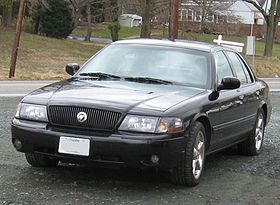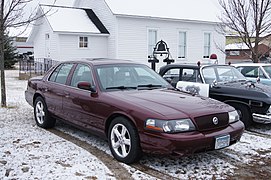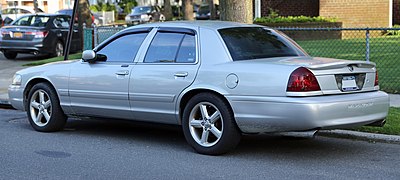How Many Mercury Marauder X100 Are Registered
| Mercury Marauder | |
|---|---|
 2003–2004 Mercury Marauder | |
| Overview | |
| Manufacturer | Mercury (Ford) |
| Product |
|
| Model years |
|
| Body and chassis | |
| Course | Full-size |
| Layout | FR layout |
The Mercury Marauder is an automobile nameplate that was used by three distinct total-size cars produced by the Mercury segmentation of Ford Motor Company. Deriving its proper name from the about powerful engines bachelor to the Mercury line, the Marauder was marketed as the highest-performance version of the full-size product range.
During its start production run, the Mercury Marauder was a trim choice on standard Mercury coupes; the equivalent of the Ford Galaxie 500 and 500/XL, the Marauder was given a "fastback" rear roofline. For 1966, the Marauder was replaced by the similar Mercury S-55; remaining the analogue of the 500XL, the S-55 transitioned the Marauder from a trim pick to a distinct model.
For its 2d production run, the Mercury Marauder returned for 1969 as a fastback version of the Mercury Marquis.[1] Designed to span the gap between the Mercury Cougar and Continental Mark III, the Mercury Marauder was repackaged as a personal luxury car. Subsequently the 1970 model year, the Mercury Marauder was discontinued.
For the 2003 model year, the Mercury Marauder nameplate was revived as a high-functioning variant of the full-size One thousand Marquis. After lower than expected sales, the Marauder was discontinued at the terminate of the 2004 model year. As it was the last nameplate introduced on the Panther platform architecture, the Mercury Marauder remains the last rear-wheel bulldoze sedan introduced by Ford Motor Company in North America (equally of the 2020 model year).
The nameplate marauder is a person engaged in banditry or related activity.
Origin of proper noun [edit]
The Marauder proper noun made its first appearance in 1958 as Ford introduced a new family of V8 engines for its Mercury, Edsel, and Lincoln brands. Exclusive to Mercury was a 383 cu in (6.three 50) V8 engine. Dubbed Marauder, information technology produced 330 hp (246 kW; 335 PS) with an optional 4-barrel carburetor. In that tune, the engine was bachelor in the Montclair and Colony Park. Shared with Lincoln, a 360 hp (268 kW; 365 PS) 430 cu in (7.0 L) V8 was bachelor every bit an pick. Exclusive to Mercury, a Super Marauder triple ii-barrel carburetor became the commencement mass-produced engine sold in the The states with an advertised 400 hp (298 kW; 406 PS) output;[two] the selection was available on all Mercury vehicles, and was offered as a competitor to the Chrysler 300C high-performance coupe.
For 1959, the Super Marauder selection was discontinued; the 430 remained, although retuned with slightly lower engine output. For 1960, 383 Marauders became optional in all Mercury vehicles, including the Monterey, Park Lane, and Commuter.
For the 1961 model year, the 383 and 430 big-block engines were phased out of the Mercury division, equally the production cycle of Edsel-based vehicles ended and Ford sought to bring Mercury closer to the Ford brand. In response, Mercury shifted the use of the Marauder name on smaller Ford Fe V8 engines.
First generation (1963–1965) [edit]
| Get-go generation | |
|---|---|
 1964 Mercury Marauder 2-door hardtop | |
| Overview | |
| Model years | 1963½–1965 |
| Body and chassis | |
| Body way | 2-door hardtop 4-door hardtop |
| Platform | Full-size Ford |
| Related | Mercury Monterey Mercury Montclair Mercury Park Lane |
| Powertrain | |
| Engine | 390 cu in (six.4 L) V8 406 cu in (6.7 L) V8 427 cu in (7.0 L) V8 |
| Transmission | 3-speed manual four-speed manual 3-speed automatic |
The Mercury Marauder nameplate made its debut as a trim packet of each of the four Mercury full-size series, including the Monterey, Montclair, Due south-55 (1963 only), and Park Lane in the Spring of 1963. For the starting time fourth dimension for a mid-year introduction, the Marauder was introduced as a "1963½" model (every bit was an entire line of new, "sports" models from Ford in many of the existing series). All 1963½ Marauders were two-door hardtops.
In sharp contrast to the distinctive reverse-slant "Breezeway" roofline option, the Marauder hardtop coupe was styled with a sloping notchback rear roofline; matching the same roofline that was introduced at the same time on the gimmicky Galaxies. This roofline was optimized to brand the big sedan more than competitive for stock auto racing. Along with the "sportier" roofline, the Marauder trim package included bucket seats and central panel, similar to its Ford counterpart. Withal, the base model Marauder came with a front bench seat and a Column shift unlike the S-55 package.

1965 Mercury Montclair Marauder iv-door hardtop
For 1964, the availability of Mercury Marauder expanded to four-door hardtops; forth with two-doors, four-door hardtops too included a fastback roofline. The blocky "Breezeway" models continued as before.
Shared with the residuum of the Mercury sedan line, the Mercury Marauder was powered past Ford "Fe-Series" V8 engines, shared with the big Fords and the Thunderbird. A 390 cubic-inch Marauder V8 was standard, with a 427 cubic-inch Super Marauder V8 replacing a 406 V8 in 1964. Along with iii-speed and 4-speed manual transmissions, a 3-speed "Merc-O-Matic" automated transmission was offered.
For 1965, Mercury advertising emphasized the machine's luxury and close relationship with Lincoln. This meant deemphasizing functioning and sporty styling. This followed a general tendency toward more luxury with the introduction of the Ford Galaxie 500 LTD, Chevrolet Impala Caprice, and Plymouth Fury VIP. Yet Mercury continued to offer the Marauder choice in all three serial (Park Lane, Montclair, and Monterey) for both the hardtop coupe and hardtop sedan; however it wasn't heavily advertised (and not even mentioned in dealer brochures). Marauders got a tiny emblem (with flag) on the "C" colonnade to distinguish them from other models. All total size Mercury hardtop coupes got the same "slantback" roofline as in the big Ford, which was basically a more sharply-angled version of the 1964 Marauder roofline. Iv-door hardtops got a new formal "limousine" styled notchback roofline that was shared with Ford's Galaxie hardtop sedans. Mercury continued to advertise the large-block FE-series V8s as "Marauder" engines.
For the 1966 model year, as Mercury shifted away from full-size functioning vehicles, the Marauder was replaced by a repackaged South-55; the move also consolidated the options of iii model lines into a distinct nameplate.
Second generation (1969–1970) [edit]
| Second generation | |
|---|---|
 1969 Mercury Marauder X-100 | |
| Overview | |
| Model years | 1969–1970 |
| Torso and chassis | |
| Body manner | 2-door hardtop |
| Related |
|
| Powertrain | |
| Engine | 390 cu in (6.iv 50) Iron V8 429 cu in (7.0 50) 385 V8 |
| Transmission | 3-speed FMX/SelectShift automatic iii-speed C6/SelectShift automatic 3-speed manual |
| Dimensions | |
| Wheelbase | 121.0 in (3,073 mm)[3] |
| Length | 219.i in (5,565 mm)[three] |
| Width | 79.half-dozen in (ii,022 mm)[iii] |
| Peak | 53.5 in (i,359 mm)[3] |
| Curb weight | 4,328 lb (one,963 kg)[3] |
For the 1969 model year, Mercury returned the Marauder nameplate to its production line.[1] Repackaged as a personal luxury car, the Marauder replaced the performance-oriented Due south-55.
Slotted below the Marquis in size, the Marauder was derived from multiple Mercury and Ford vehicles. Sharing its fastback roofline with the Ford Twoscore and Ford Galaxie 500 SportsRoof,[1] the Marauder shared its forepart sheetmetal (and interior trim) with the Marquis. The Marauder shared its 121-inch wheelbase with Ford sedans (and the Colony Park station wagon). Similar to other 1960s vehicles with fastback rooflines, its rear window was "tunneled", with large rear C-pillars. In the rear quarter panels, non-functional louvered side air intakes were added equally a styling element.
By the end of the 1960s, demand for high-performance full-size cars had largely disappeared. In total, Mercury would sell nigh 15,000 examples for 1969, and barely a tertiary of that for 1970; in comparison to the Marauder, Mercury would sell nearly 173,000 Cougars at the same time. Within the Lincoln-Mercury Partitioning, the far more expensive Continental Mark 3 outsold the Marauder more than two-to-ane from 1969 to 1970.
Powertrain [edit]
Standard versions of the Marauder were equipped with the 390 cu in (6.4 L) Ford FE engine and a transmission iii-speed transmission.[4] The Marauder 10-100 was only equipped with the 360 hp (268 kW; 365 PS) 429 cu in (vii.0 L) engine with a 3-speed FMX automated as an option.[5] The only transmission available with the 429 was the 3-speed Ford C6 automated.[1]

1969 Mercury Marauder X-100
Mercury Marauder X-100 [edit]
To offer a higher-functioning version of the Marauder, Mercury introduced the Marauder Ten-100. While nearly all features of the X-100 were corrective, the Marauder X-100 offered a option of twin comfort lounge seats, bench seat or bucket seats with a floor panel housing a U-shaped automatic transmission shift handle. The X-100 as well featured Kelsey-Hayes road wheels forth with rear fender skirts.[1]
Revival (2003–2004) [edit]
| Third generation | |
|---|---|
 2003–2004 Mercury Marauder | |
| Overview | |
| Production | May 2002 – June 25, 2004[six] [seven] |
| Model years | 2003–2004 |
| Assembly | St. Thomas Assembly Institute, St. Thomas, Ontario, Canada |
| Trunk and chassis | |
| Body manner | 4-door sedan |
| Platform | Ford Panther platform |
| Related | Mercury Thou Marquis Ford Crown Victoria Lincoln Town Car |
| Powertrain | |
| Engine | 302 hp 4.6 L Modular DOHC V8 |
| Transmission | four-speed 4R70W automatic (2003) 4-speed 4R75W automatic (2004) |
| Dimensions | |
| Wheelbase | 114.7 in (2,913 mm) |
| Length | 212.0 in (5,385 mm). |
| Width | 78.2 in (ane,986 mm). |
| Height | 56.8 in (1,443 mm). |
For 2003, Mercury revived the Marauder nameplate after a 33-year hiatus. Like in concept to its 1960s namesake, the new Marauder offered upgraded chassis, suspension, and powertrain components over the standard Grand Marquis. For the first time since 1960, Mercury offered a total-size sedan with no Ford counterpart, developing it as a marketplace successor to the 1994-1996 Chevrolet Impala SS.[8] When the Marauder was cancelled, Chrysler reintroduced the 2005 Chrysler 300 as a rear drive luxury sedan with the all-new Hemi V8.
The introduction of the Marauder launched a near-complete replenishment of the Mercury model line.[nine] Though the Grand Marquis sedan and Mountaineer SUV would remain in production, from 2004 to 2006, Mercury introduced the Monterey minivan (2004) and Mariner SUV (2005); the Sable was replaced by the Montego and Milan sedans (2005 and 2006).
After the stop of the 2004 model year, the Marauder was discontinued with no direct Mercury or Ford replacement.[10] Initially predicted for sales of xviii,000 vehicles per year,[9] the revived Marauder sold slowly, with only 11,052 sold over its two-twelvemonth production (compared to nearly 180,000 Grand Marquis sold in the aforementioned time). In a key marketing success, the Marauder attracted younger buyers into Lincoln-Mercury showrooms; the average age of its buyer (51) was 18 years younger than that of the Yard Marquis (69).[9]
Evolution [edit]
At the 2002 Chicago Auto Show, Ford introduced the Mercury Marauder as a concept auto.[11] Serving as a preview of the production vehicle, the 2002 concept car was a five-passenger, two-door convertible.[12] Starting life every bit a 1999 Ford Crown Victoria Lx, the trunk was reconfigured and the 215hp 4.6L V8 replaced by a 335hp supercharged 4.6L SOHC V8.[12]
The first total-sized convertible produced by Ford since the 1972 Ford LTD convertible and the first total-sized two-door sedan (by Ford) since 1987, the Marauder convertible was strictly intended as a concept automobile. At the time of its evolution, production of the ii-door convertible was under consideration, related to consumer demand.[viii]
Chassis [edit]
The 2003–2004 Marauder utilized the Panther platform, adopting the chassis upgrades introduced as function of its 2003 update (including the introduction of rack-and-pinion steering). The Marauder also used heavier-duty brake and intermission components from the Ford Crown Victoria Police Interceptor.
For product Marauders, Mercury used a 302hp 4.6L DOHC V8; an evolution of the Lincoln Mark VIII engine, the V8 was shared with the Mustang Mach 1 and Lincoln Aviator. For 2003, the engine used a 4-speed 4R70W automatic, switching to a 4R75W automatic for 2004.
The Marauder shared its express-sideslip differential (and iii.55:1 rear-axle ratio) with the Crown Victoria Police Interceptor,[thirteen] along with its aluminum driveshaft.
Torso [edit]
In line with the B-body Chevrolet Impala SS, the 2003 Marauder was given a monochromatic appearance, with a wide majority of cars sold in black. In contrast to the Chiliad Marquis, the merely chrome on the Marauder is its window trim, wheels, and Mercury emblems on the grille and trunklid.
On the exterior, the Marauder shares nearly of its trim with the Grand Marquis; much of the rear and side trim is shared with the Crown Victoria LX Sport. Both bumpers are unique to the Marauder; the rear features the model proper name embossed on the bumper and is modified further to accommodate the larger Megs chrome tailpipe tips. The front bumper was redesigned with a central air intake added to ameliorate engine ventilation; round Cibié fog lamps were added below the headlights. The headlight and corner low-cal lenses (from the Thousand Marquis) had their non-reflective surfaces blacked out and the grille was painted black with a body-colour surroundings. The taillight and contrary light lenses (from the Crown Victoria LX Sport) were dark-tinted to the minimum of DOT standards. Unique to the Marauder, the eighteen-inch five-spoke wheels have center caps with a revival of a 1960s Mercury keepsake (a silhouette of the Roman god Mercury).
The interior of the Marauder resembled the configuration of the 2002 concept convertible, adopting a v-seat layout with a middle console-mounted manual shifter (shared with the Crown Victoria 60 Sport and Grand Marquis LSE). Leather seating was standard, with (fake) satin aluminum trim replacing wood trim. Unique to the Marauder, the musical instrument panel was redesigned, with aluminum-finish gauges, a 140-mph speedometer; unique among Panther platform vehicles (at the fourth dimension), the Marauder was fitted with a tachometer, requiring the relocation of the voltmeter and oil pressure level gauges (forward of the shifter).
-
Mercury Marauder, rear view
-

Mercury Marauder (Nighttime Toreador Red)
-

Mercury Marauder (Silver Birch)
-

2004 Mercury Marauder (Silver Birch), showing optional trunk spoiler
Sales [edit]
| 2003-2004 Mercury Marauder sales | |||||
|---|---|---|---|---|---|
| Model year | Sales (by color) | ||||
| Blackness | Silver Birch | Dark Pearl Blueish | Dark Toreador Red | Total yearly sales | |
| 2003 | 7,093 | 417 | 328 | N/A | vii,838 |
| 2004 | 1,237 | 997 | N/A | 980 | three,214 |
| Total sales | 11,052 | ||||
References [edit]
- ^ a b c d e Odin, L.C. (2016). A curtailed guide to the Ford and Mercury full-size automobile product 1969-1978. Belvedere Publishing. ASIN B01HE91Y4K.
- ^ Sessler, Peter C. (2010). Ultimate American V-viii Engine Data Book (2d ed.). Motorbooks. p. 139. ISBN9780760336816 . Retrieved April nineteen, 2016.
- ^ a b c d e "Mercury Marauder 10-100 (1970) total detailed specifications list and photo gallery". Retrieved 25 January 2014.
- ^ Hunting, Benjamin. "1969-1970 Mercury Marauder X100: Dearborn'due south Forgotten Luxury Muscle Automobile". Driving Line. Nitto Tire. Retrieved 20 Dec 2019.
- ^ Auto Editors of Consumer Guide (21 June 2007). "1969 Mercury Marauder X-100". HowStuffWorks.com . Retrieved 7 Feb 2019.
- ^ "Ford's St. Thomas Assembly Plant Is A Globe Beater". Autointell. 10 May 2002. Retrieved sixteen Nov 2017.
- ^ "Last Marauder Made tonight!". mercurymarauder.internet.
- ^ a b Truett, Richard (five November 2001). "Mercury follows Impala formula for Marauder". Automotive News . Retrieved 16 November 2017.
- ^ a b c "Mercury Marauder sales fall short of goals". Automotive News. January 29, 2003. Retrieved January 21, 2016.
- ^ Wilson, Amy (March 22, 2004). "Mercury kills Marauder". Automotive News . Retrieved January 21, 2016.
- ^ "Mercury Marauder returns to Chicago every bit a convertible concept" (Press release). Ford Media. February half-dozen, 2002. Archived from the original on October seven, 2012. Retrieved March 11, 2016.
- ^ a b Joslin, Tom (September 3, 2011). "Topless Mercury Marauder concept car on Ebay". Jalopnik.com . Retrieved January 21, 2016.
- ^ George, Patrick (26 July 2013). "Why The Mercury Marauder Is A Futurity Classic". Jalopnik . Retrieved 16 November 2017.
Farther reading [edit]
- Edmunds.com, 2003 Marauder Review
- AutomobileMag.com, 2003–2004 Mercury Marauder, Joe Lorio
- Car and Driver, July 2002, 2003 Mercury Marauder - Reviews / Road Tests, John Phillips
- Car and Driver, 2004 Mercury Marauder, User Road Tests [ permanent dead link ]
- Motor Trend, July 2002, Merc Meets Merc, Marauder and S500: Two cool, bad-ass powerbrokers on the run, Todd Lassa
- JD Power Quality Survey, 2003 Mercury Marauder
External links [edit]
- Mercury Marauder at the Internet Movie Cars Database
How Many Mercury Marauder X100 Are Registered,
Source: https://en.wikipedia.org/wiki/Mercury_Marauder
Posted by: mullettrivinquister.blogspot.com



0 Response to "How Many Mercury Marauder X100 Are Registered"
Post a Comment